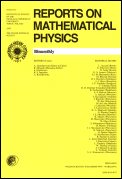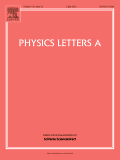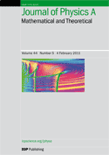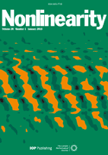
REPORTS ON MATHEMATICAL PHYSICS
Scope & Guideline
Pioneering Discoveries in Mathematical Physics
Introduction
Aims and Scopes
- Mathematical Foundations of Physics:
Exploration of the mathematical structures underpinning physical theories, including quantum mechanics, general relativity, and statistical mechanics. - Quantum Mechanics and Quantum Information:
Research on quantum systems, quantum entanglement, and quantum information theory, including applications in quantum computing and cryptography. - Nonlinear Dynamics and Solitons:
Investigation of nonlinear phenomena, soliton solutions, and integrable systems across various physical contexts, including fluid dynamics and field theories. - Statistical Mechanics and Thermodynamics:
Studies on Gibbs measures, phase transitions, and statistical properties of physical systems, often employing mathematical rigor to derive new insights. - Geometric and Algebraic Methods:
Utilization of geometric and algebraic techniques in understanding physical systems, particularly in the context of gauge theories and symmetries. - Mathematical Models in Cosmology and General Relativity:
Application of mathematical techniques to solve problems in cosmology and the study of spacetime geometries in general relativity.
Trending and Emerging
- Quantum Computing and Quantum Information Theory:
There is a notable increase in research related to quantum computing, including studies on quantum codes and entangled states, reflecting the rapid developments in this field. - Nonlocal and Fractional Differential Equations:
An emerging focus on nonlocal and fractional differential equations indicates a growing interest in complex systems and their mathematical modeling, particularly in physical contexts. - Geometric Analysis in Physics:
Research on geometric methods applied to physical theories, particularly in the context of quantum gravity and gauge theories, is increasingly prominent in current publications. - Mathematical Models in Complex Systems:
There is a rising trend in studies that apply mathematical modeling to complex systems, including multi-species stochastic models and dynamics of entangled states, showcasing interdisciplinary approaches. - Advanced Topics in Statistical Mechanics:
A surge in papers addressing advanced topics within statistical mechanics, such as Gibbs measures and their applications in various contexts, illustrates a deeper exploration of this field.
Declining or Waning
- Classical Mechanics and Traditional Dynamics:
Research on classical mechanics has become less frequent as the journal's scope shifts towards more modern and complex theories, such as quantum mechanics and nonlinear dynamics. - Elementary Particle Physics:
Papers specifically dedicated to elementary particle physics are decreasing, possibly due to a growing emphasis on mathematical frameworks and less on specific particle models. - Basic Thermodynamics:
The exploration of fundamental thermodynamic principles appears to be waning, as the journal increasingly prioritizes advanced statistical mechanics and non-equilibrium thermodynamics.
Similar Journals

PHYSICS LETTERS A
Bridging Theory and Application in PhysicsPhysics Letters A is a renowned scientific journal published by Elsevier, dedicated to the field of physics and astronomy. Established in 1963, it has continuously evolved, offering a platform for the swift dissemination of significant research findings in various branches of physics. As of 2023, it holds a commendable Q2 ranking in the category of Physics and Astronomy (miscellaneous) and ranks 69th out of 243 journals in the same domain according to Scopus, positioning itself in the 71st percentile of academic impact. With its comprehensive scope, Physics Letters A provides a vital resource for researchers, professionals, and students, facilitating academic discourse and advancing knowledge across the field. Although it does not currently offer Open Access options, its rigorous peer-review process ensures high-quality content. It is centrally located in Amsterdam, Netherlands, and continues to be an essential outlet for innovative contributions to the physics community through the year 2024 and beyond.

Advances in Mathematical Physics
Fostering Collaboration in Mathematical PhysicsAdvances in Mathematical Physics is a premier open-access journal published by HINDAWI LTD, dedicated to the dissemination of research in the fields of applied mathematics and physics. With its ISSN 1687-9120 and E-ISSN 1687-9139, this journal has been a vital platform for innovative studies since its inception in 2009, fostering a collaborative environment for researchers and professionals alike. The journal features a wide range of topics, including but not limited to mathematical models, computational physics, and interdisciplinary applications, thus attracting a diverse readership. Ranked in the Q3 quartile for both Applied Mathematics and Physics and Astronomy, it serves as a significant resource for academics looking to explore cutting-edge developments and theoretical advancements. With an emphasis on open accessibility, Advances in Mathematical Physics ensures that research findings are readily available to the global academic community, leveling the playing field for emerging scholars and seasoned researchers. By consistently showcasing high-quality manuscripts, the journal contributes substantially to the fields of mathematics and physics, encouraging scholarly dialogue and advancing knowledge across a myriad of applications.

INTERNATIONAL JOURNAL OF MODERN PHYSICS A
Fostering collaboration in the realms of astrophysics and high energy physics.INTERNATIONAL JOURNAL OF MODERN PHYSICS A, published by WORLD SCIENTIFIC PUBL CO PTE LTD, stands as a pivotal platform in advancing the frontiers of research within the fields of Astronomy and Astrophysics, Atomic and Molecular Physics, and Nuclear and High Energy Physics. Established in 1989, this journal has systematically contributed to the scientific community, with a demonstrated impact as indicated by its Q2 category rankings across these critical disciplines in 2023. Researchers and professionals are encouraged to engage with its rigorous peer-reviewed content, fostering a deeper understanding of modern physics theories and experimental breakthroughs. Although the journal operates under a conventional access model, it remains a vital resource for those seeking to disseminate their findings and stay abreast of cutting-edge developments. With an emphasis on quality and breadth of research, the journal continues to attract submissions from leading physicists and scholars, enhancing its reputation as a key academic resource.

TAIWANESE JOURNAL OF MATHEMATICS
Advancing mathematical dialogue across borders.TAIWANESE JOURNAL OF MATHEMATICS, published by the Mathematical Society of the Republic of China, is a pivotal platform for disseminating innovative research in the field of mathematics. Established in 1997 and currently encompassing works until 2024, this journal aims to foster a global dialogue among mathematicians, researchers, professionals, and students interested in diverse mathematical topics, including theoretical and applied concepts. The journal, which holds a respectable Q2 ranking in Mathematics (miscellaneous) for 2023, is acknowledged for its commitment to quality and scholarly excellence, also being listed in Scopus with a rank of #234 out of 399 in General Mathematics, positioning it in the 41st percentile among its peers. By providing unrestricted access to its research outputs, TAIWANESE JOURNAL OF MATHEMATICS ensures that vital findings are available to a broad audience, thus contributing significantly to the advancement of mathematical sciences both in Taiwan and globally.

Journal of Physics A-Mathematical and Theoretical
Fostering Collaboration in Cutting-Edge Physics ResearchThe Journal of Physics A-Mathematical and Theoretical, published by IOP Publishing Ltd, is a premier peer-reviewed journal dedicated to advancing the understanding of mathematical physics, modeling, and simulation methods within the dynamic field of physics and astronomy. Established in the United Kingdom, this journal has made significant contributions over the years, maintaining a strong reputation as a Q1 and Q2 ranked journal across various categories, reflecting its influence in the scientific community. With a focus on innovative and theoretical approaches, it provides a platform for researchers, professionals, and students to disseminate their findings and engage with groundbreaking methodologies. Despite its lack of open access options, the journal's high impact factor and Scopus rankings, which place it in the top percentiles across multiple disciplines, underscore its critical role in fostering scholarly communication and collaboration in mathematical and theoretical physics. As we move through its converged years from 2007 to 2024, the Journal of Physics A continues to be a pivotal contributor to the landscape of contemporary physics, stimulating discussions and advancing knowledge in an ever-evolving realm.

ANNALES HENRI POINCARE
Connecting Scholars Worldwide in the Quest for KnowledgeANNALES HENRI POINCARE is a prestigious journal published by Springer International Publishing AG, dedicated to advancing research in the fields of Mathematical Physics, Nuclear and High Energy Physics, and Statistical and Nonlinear Physics. With an impressive Q1 ranking in its respective categories as of 2023, this journal is recognized as a vital resource for academic researchers, professionals, and students engaged in frontier studies of theoretical and applied physics. The journal's commitment to high-quality peer-reviewed articles promotes significant contributions to the understanding of complex physical phenomena, making it essential reading for anyone seeking to stay abreast of developments in these dynamic fields. Additionally, ANNALES HENRI POINCARE offers open access options to enhance the visibility and accessibility of groundbreaking research, underscoring its role in fostering collaborative scientific inquiry and innovation. Since its inception in 2000, it has continually provided a platform for scholars worldwide to disseminate their findings and engage with the broader scientific community, thus establishing itself as a cornerstone of academic literature.

NONLINEARITY
Pioneering Research in Applied Mathematics and PhysicsNONLINEARITY is a premier academic journal published by IOP Publishing Ltd, dedicated to advancing the field of complex systems through the lens of nonlinear science. Since its inception in 1988, the journal has established itself as a vital resource for researchers and professionals alike, offering a robust platform for disseminating high-quality research in areas such as applied mathematics, mathematical physics, and statistical and nonlinear physics. With an impressive Q1 ranking across multiple pertinent categories, including Applied Mathematics and Mathematical Physics, NONLINEARITY ranks among the top journals globally, making it essential reading for those seeking to deepen their understanding of nonlinear phenomena. Although it does not operate under an open-access model, its rich repository of rigorous articles significantly contributes to academia, fostering innovative thought and facilitating cutting-edge research. Located in the heart of the United Kingdom at TEMPLE CIRCUS, TEMPLE WAY, BRISTOL BS1 6BE, NONLINEARITY continues to be at the forefront of the scientific community, championing new discoveries and interdisciplinary dialogue within its dynamic scope.

Communications Physics
Catalyzing discoveries in the realm of Physics and Astronomy.Communications Physics is a premier open access journal published by Nature Portfolio, dedicated to disseminating high-quality research in the field of Physics and Astronomy. Since its inception in 2018, the journal has rapidly established itself as a vital platform for innovative scientific communication, boasting an impressive Impact Factor and achieving Q1 status in the 2023 category of Physics and Astronomy (miscellaneous). With a Scopus rank of #31 out of 243, placing it within the 87th percentile, Communications Physics attracts a global audience of researchers, professionals, and students eager to engage with cutting-edge findings. The journal supports open access, ensuring that research is freely available to the public, which enhances its visibility and encourages broader discussions within the scientific community. Located in Berlin, Germany, Communications Physics aims to bridge the gap between various disciplines within physics, fostering interdisciplinary collaboration and inspiring future research endeavors.

Annals of Physics
Elevating the discourse in Physics and Astronomy since 1957.Annals of Physics is a premier journal published by Academic Press Inc Elsevier Science, specializing in the expansive field of Physics and Astronomy. Since its inception in 1957, this journal has played a pivotal role in disseminating high-quality research and advancements across various sub-disciplines of physics. With a notable impact factor making it rank in the Q1 category for 2023, it stands among the top tier of scholarly publications, specifically sitting at Rank #63 out of 243 in the field, placing it in the 74th percentile according to Scopus metrics. Researchers are encouraged to submit their findings to reach a broad audience without the constraints of Open Access fees, promoting extensive visibility within the academic community. As we look ahead to 2024, Annals of Physics continues to be an essential resource for professionals, students, and academics striving to advance the frontiers of knowledge in physics and astronomy.

Annales de l Institut Henri Poincare D
Elevating Scholarly Research in Quantum RealmsAnnales de l Institut Henri Poincare D, published by the esteemed EUROPEAN MATHEMATICAL SOCIETY, is a notable open-access journal dedicated to advancing the fields of mathematics and physics. With an ISSN of 2308-5827 and E-ISSN 2308-5835, this journal has risen to prominence since its inception in 2014, benefiting from a significant level of accessibility since 2022. Based in Germany, it provides a rigorous platform for scholarly research in areas such as Algebra and Number Theory, Discrete Mathematics and Combinatorics, Geometry and Topology, Statistical and Nonlinear Physics, and Statistics and Probability, where it has achieved a Q1 quartile ranking in 2023. With its Scopus ranking reflecting excellent percentile standings, particularly in Algebra and Geometry, Annales de l Institut Henri Poincare D is essential reading for researchers and academics seeking to engage with cutting-edge developments and innovative methodologies in their respective fields. Researchers can find it valuable not only for its high-quality publications but also for its commitment to fostering a global knowledge exchange in mathematics and physics.